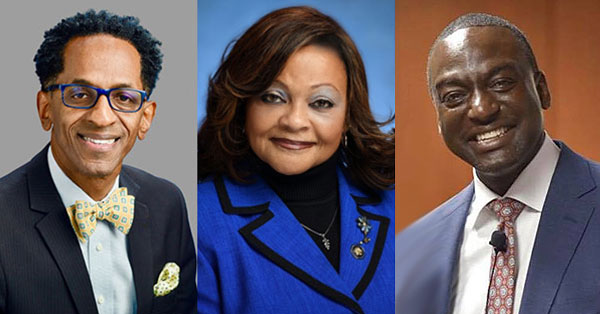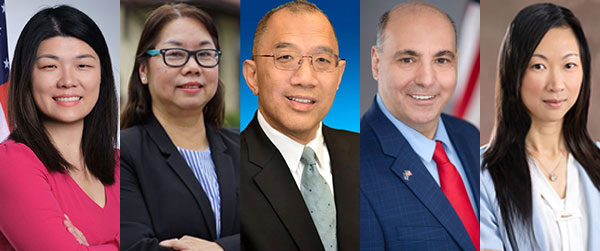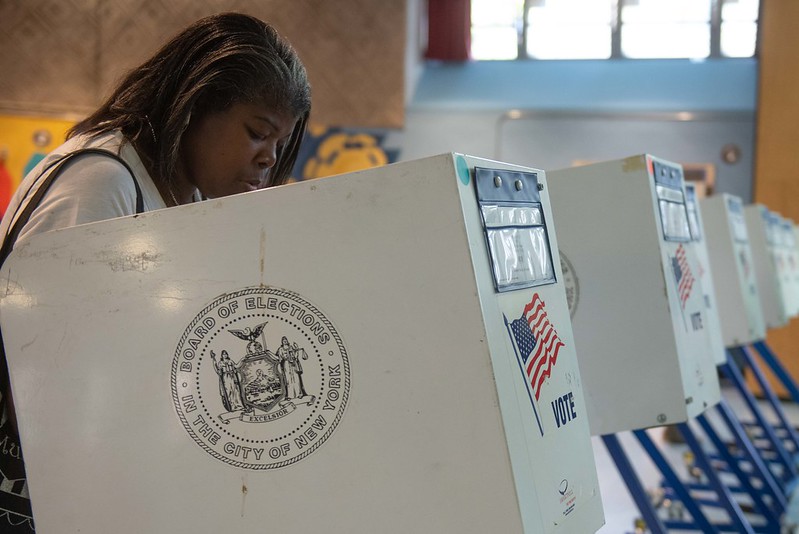
Mayor Adams & Speaker Adams shake on the budget deal (photo: @NYCMayor)
Mayor Eric Adams and City Council Speaker Adrienne Adams announced on Thursday a deal on a massive $107 billion budget for the 2024 fiscal year, just days before the July 1 deadline, marking the conclusion of months of contentious negotiations between the two sides of City Hall. The full Council is scheduled to vote the budget through on Friday morning.
This budget is the largest at adoption in city history, adding $6 billion in spending compared to the budget adopted last June, largely because of spending on municipal labor contracts and the costs of services for the large influx of migrant asylum-seekers.
“The agreement we reached today comes in the midst of a budget cycle dominated by great challenges and unexpected crises,” Mayor Adams said, after a particularly tense “budget handshake” with the speaker at City Hall. “But I'm proud to say we have successfully navigated through these many crosscurrents to arrive at a strong and fiscally responsible budget that uplifts everyday New Yorkers and their families.”
The mayor acknowledged that while the city did not make “big dollar investments” across the board, there were nonetheless “smart, strategic” allocations to youth services, mental health, public safety, education, seniors, cultural institutions and libraries, sanitation, and more that will have major impacts.
Unlike recent years, the budget negotiations came down to the wire, after tense battles over the mayor’s recurring attempts to make sweeping if mostly modest cuts across city agencies, which the Council repeatedly opposed as it sought to boost the city’s social safety net.
Speaker Adams acknowledged that the bulk of the budget fight was spent on restoring proposed cuts, and expressed disappointment that the Council wasn’t successful across the board. “These negotiations were not easy and, in fact, they were uniquely challenging because of how much it focused on restoring cuts to so many important programs,” she said, speaking just after the mayor as he looked on.
Many in the Council also had to contend with the primary election earlier this week, since all 51 seats are up for election this year, adding another complication in the middle of the budget process. In a sign of the fraught relationship with the more moderate mayor and challenging budget negotiations, many of the Council’s Progressive Caucus members were absent from the annual City Hall celebration of a budget deal.
In contrast with last year, when the city was also flush with revenue and federal aid, the administration faced additional fiscal pressures this year. Several major municipal labor contracts have been settled while others remain pending, which accounted for most of the added spending – in total, the administration allocated $16 billion across the next four fiscal years for all labor settlements.
About $2.9 billion in the next fiscal year will go to the costs of sheltering and providing services to asylum seekers, which has already cost the city about $1.4 billion in the current fiscal year — though there is some state and federal aid coming to help with those costs. More than 81,000 migrants have arrived in the city in the last year, and more than 51,000 remain in the city’s care, according to the Adams administration.
Other areas where the city added funding, though they pale in sum comparison, include a $20 million baseline increase for the Fair Fares discounted MetroCard program, bringing the total there to $95 million; a Cost of Living Adjustment (COLA) for nonprofit human service providers, with funding baselined at $100 million in the 2024 fiscal year and growing to $150 million baselined in fiscal year 2025; a $46 million increase for legal service providers, including for Right to Counsel cases in eviction proceedings; and $30.3 million for supportive programs for K-12 students including mental health services, arts education, shelter-based coordinators, Immigrant Family Engagement, and community schools; $16 million in total for childcare for undocumented families via the Promise NYC program launched this fiscal year; and $15 million more to expand 3K, by converting nearly 1,900 school day/school year seats to extended day/extended year seats.
The Adams administration took several steps to cut spending over the last several months, including successive Programs to Eliminate the Gap (PEGs) and a vacancy reduction initiative, which together saved more than $4.7 billion between the current and next fiscal year. Revenues also came in higher than expected by about $2.1 billion in the current fiscal year, helping balance the budget for next fiscal year with the opportunity for the Council to secure restoration of some of the mayor’s proposed reductions.
“We achieved this without cutting services, laying off employees or raising taxes,” Mayor Adams said of the balanced budget for fiscal year 2024.
The budget also sets aside $8 billion in reserves, including $1.2 billion in the General Reserve, $2 billion in the Rainy Day Fund, $4.58 billion in the Retiree Health Benefits Trust fund, and $250 million in the Capital Stabilization Reserve.
“[The budget] is on time, balanced and fiscally responsible. It strategically directs our resources to programs that will support everyday New Yorkers and it represents a balance of administration and Council priorities,” the mayor said.
Last year, the mayor and Council clashed over cuts to individual school budgets over declining enrollment that were approved as part of the budget, though the Council tried to argue that the administration had been misleading. But this budget will not reduce any school budgets at the start of the school year, the mayor reiterated on Thursday, though he said that could change (with funding up or down) in midyear adjustments when final enrollment numbers are tallied.
Speaker Adams gave a sobering assessment of how the final budget deal unfolded. “Our focus in this budget has been to protect the essential services that the people of this city rely on to be healthy, safe and successful,” she said, decrying the cuts that the Council had to fight hard to restore.
She noted that the Council’s first-ever female majority informed its budget priorities. “The inequities that women, and particularly women of color, face throughout our lives that undermine us, our communities and the city are issues that must be addressed. Resolving these inequities was the focus of many of our budget priorities,” she said.
Among the many cuts that the Council was successful in reversing were $36.2 million from public libraries; $32.4 million from the City University of New York; $40 million for other cultural institutions; $32.9 million from the New York City Housing Authority’s Vacant Unit Readiness Program; $22 million for litter basket collection; and $7 million from older adult meals.
With federal covid relief funding running out in the next few years and with revenues also expected to slow, the speaker conceded, “The reality is we're heading into more challenging years.” But she emphasized that the administration and Council need to collaborate more closely on the budget, rather than replicate the budget dance that characterized this year’s process.
“While the Council's focus this year was to restore cuts to essential services, our city must shift away from this counterproductive budgeting approach and move forward through the lens of expanding upon what New Yorkers need, not what they can do without,” she said.
“A budget is more than just an itemized list of expenditures, it's a values document,” said Council Member Justin Brannan, chair of the Council’s finance committee, emphasizing the “thoughtful, surgical investments” made in the budget. “You can tell me what you care about, but you prove it to me by showing me what you spend your money on, especially when times are tough and money is tight. It all comes down to priorities and from the start of these negotiations, the Council was laser focused on protecting what New Yorkers need to recover, succeed, be healthy and safe. New Yorkers don't run and hide, we stand and fight. The city's best days are ahead of us and I would never bet against New York City.”
One of the major successes for the Council was shifting $175 million in capital funding for the Department of Housing Preservation and Development into the earlier years of the city’s capital strategy, and achieving a $4 billion capital allocation for housing in fiscal year 2024, by which the Council’s insistence helps the mayor meet a campaign promise he had yet to fulfill.
Questions remain, however, about whether the personnel will be there at HPD and other city agencies to adequately provide city services, meet major goals, and address several crises. The new budget funds more than 20,000 vacant positions across city agencies, indicative of an ongoing personnel crisis that has already hurt service-delivery and the Adams administration has only recently begun to take modest steps toward addressing.
Reactions
Comptroller Brad Lander, the city’s chief financial officer, said in a statement that the budget agreement did not tackle major long-term challenges while also including “short-sighted cuts” like $17 million from restorative justice programs at Rikers Island and some $9 million to CUNY.
He also noted that the administration did not take any steps to address the costs of the migrant crisis. “The Administration wields the high cost of providing shelter for asylum seekers as a rationale for belt tightening, yet did not provide significant funding for urgent legal assistance that would significantly reduce the City’s long-term costs,” Lander said. “City Hall announced a plan to connect asylum seekers with pro bono legal support to apply for status and work authorization, but this budget does not allocate meaningful dollars to scale up legal services that will help people gain employment, exit the shelter system, and contribute to our local economy. This is a shortsighted approach to a pressing budget and human issue.”
Lander — whom Mayor Adams on Thursday again criticized for not traveling to Washington D.C. to push for federal asylum-seeker support — has also continued to urge the city to put away more funding in reserves and to back revenue-raising measures, which require state approval, to fund critical future needs.
Public Advocate Jumaane Williams expressed relief that many of the proposed cuts in the budget were prevented. “Unfortunately, a necessary focus on restoring cuts meant that many new and necessary investments were not able to be made,” he said in a statement. “Maintaining public school funding and supporting libraries should be a given, but so should strengthening and expanding services to meet the moment and the needs of the most vulnerable New Yorkers.”
He also faulted the mayor for using asylum-seekers as a “scapegoat” for failing to invest in services for all New Yorkers and the mayor’s continued opposition to raising taxes on the wealthy. “"As I have said many times – investment, not austerity, is the most effective means of meeting the compounding crises our city faces, and we just cannot point to our challenges as a reason to prevent investment,” he said.
Andrew Rein, president of Citizens Budget Commission, a nonprofit fiscal watchdog, reiterated warnings about the administration and Council compounding fiscal problems in the years ahead. “It is essentially a one-year budget that again unfortunately delays the wise but hard choices needed to stabilize the City’s fiscal future,” he said in a statement. “With the coffers temporarily bulging, the budget increases fiscal cliffs, widens future budget gaps, and misses the opportunity to deposit money into the Rainy Day Fund.”
“This burgeoning habit of funding major programs one year at a time is effectively putting the budget dance of years’ past on steroids, potentially creating massive annual service crises. Cliff dancing is dangerous and should stop,” Rein added.
Advocates expressed mixed feelings about the budget, and those who were disappointed mostly directed their ire at the mayor.
The heads of the three library systems – Brooklyn Public Library President Linda Johnson, Queens Public Library President Dennis Walcott, and New York Public Library President Anthony Marx – were ecstatic that their funding had been restored. “This is true and responsive civic leadership, and we look forward to continuing to work with the Mayor and the Council to address some of the most pressing challenges facing our city, including assisting asylum seekers, supporting teens, preparing people for the workforce, and helping kids recover from pandemic learning loss,” they said in a joint statement.
“Today, a simple handshake has upended the lives of thousands of people detained in our city jails, whose hopes for a better future rested in crucial programs that—up until June 30—supported our most vulnerable and marginalized communities,” read a statement from the Fortune Society, referencing the $17 million cut to programs in city jails that it helps provide. “These vital, life-saving services included reentry planning, nonviolent conflict resolution, hard skills training and certifications, and cognitive behavioral interventions. To say the ending of this funding is short-sighted and cruel is an understatement—it threatens to cause generational damage and trauma for decades to come and portends a decline in public safety.”
Michelle Jackson, executive director of the Human Services Council, which represents nearly 200 nonprofit human service providers, said the COLA in the budget was far below what organizations require. “This budget is not good, and it is not just,” she said in a statement. “Almost two-thirds of our workforce lives near poverty, and this agreement will not fundamentally change that - even though the Mayor found plenty of money to give generous raises to other workers.”
The Professional Staff Congress–CUNY, which represents 30,000 faculty and professional staff, praised the Council for pushing back against cuts to the system.
“Without the Council's intervention, the Mayor's budget would have dramatically compounded years of City cuts to community colleges,” said PSC-CUNY President James Davis, in a statement. He pointed out that, despite the restorations, previous cuts (based on student enrollment drops) have already hurt CUNY’s finances, leading community colleges to lose more than 300 full-time faculty and staff since 2020. “It is well documented that CUNY lifts the economic prospects of thousands of New Yorkers, including two-time CUNY graduate Mayor Adams,” Davis said. “Thankfully, the Council was able to stop the Mayor pulling the ladder of opportunity up behind him in this budget. Because these restorations were not baselined by the Mayor in this budget, the Mayor will have to decide again if he will continue to target CUNY students for cuts.”
Betsy Plum, executive director of Riders Alliance, and David Jones, president of Community Service Society, praised the expansion of the Fair Fares program. “Expanding the nation's largest low-income transit discount program will help it achieve its full potential to combat poverty and promote economic security,” they said in a statement. “We look forward to working with City Hall to make the expansion as impactful for as many people as possible.”
***
by Samar Khurshid, senior reporter, Gotham Gazette
@samarkhurshid @GothamGazette













